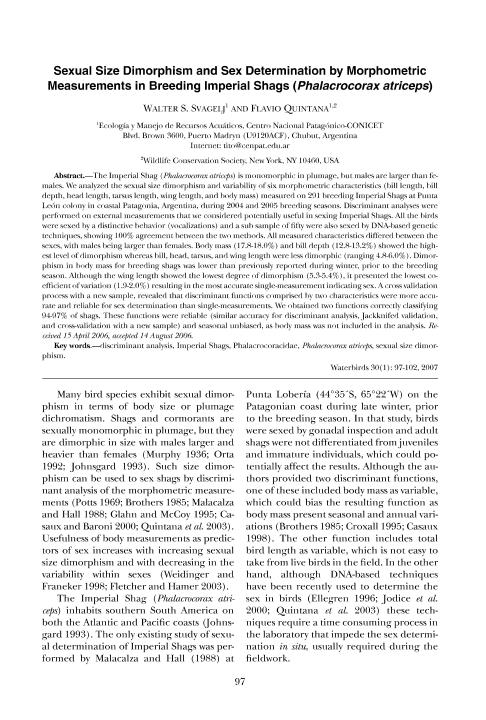Mostrar el registro sencillo del ítem
dc.contributor.author
Svagelj, Walter Sergio

dc.contributor.author
Quintana, Flavio Roberto

dc.date.available
2020-04-17T17:56:28Z
dc.date.issued
2007-03
dc.identifier.citation
Svagelj, Walter Sergio; Quintana, Flavio Roberto; Sexual size dimorphism and sex determination by morphometric measurements in breeding Imperial Shags (Phalacrocorax atriceps); Waterbird Society; Waterbirds; 30; 1; 3-2007; 97-102
dc.identifier.issn
1524-4695
dc.identifier.uri
http://hdl.handle.net/11336/102934
dc.description.abstract
The Imperial Shag (Phalacrocorax atriceps) is monomorphic in plumage, but males are larger than females. We analyzed the sexual size dimorphism and variability of six morphometric characteristics (bill length, bill depth, head length, tarsus length, wing length, and body mass) measured on 291 breeding Imperial Shags at Punta León colony in coastal Patagonia, Argentina, during 2004 and 2005 breeding seasons. Discriminant analyses were performed on external measurements that we considered potentially useful in sexing Imperial Shags. All the birds were sexed by a distinctive behavior (vocalizations) and a sub-sample of fifty were also sexed by DNA-based genetic techniques, showing 100% agreement between the two methods. All measured characteristics differed between the sexes, with males being larger than females. Body mass (17.8 - 18.0%) and bill depth (12.8 - 13.2%) showed the highest level of dimorphism whereas bill, head, tarsus, and wing length were less dimorphic (ranging 4.8 - 6.0%). Dimorphism in body mass for breeding shags was lower than previously reported during winter, prior to the breeding season. Although the wing length showed the lowest degree of dimorphism (5.3 - 5.4%), it presented the lowest coefficient of variation (1.9 - 2.0%) resulting in the most accurate single-measurement indicating sex. A cross validation process with a new sample, revealed that discriminant functions comprised by two characteristics were more accurate and reliable for sex determination than single-measurements. We obtained two functions correctly classifying 94 - 97% of shags. These functions were reliable (similar accuracy for discriminant analysis, Jackknifed validation, and cross-validation with a new sample) and seasonal unbiased, as body mass was not included in the analysis.
dc.format
application/pdf
dc.language.iso
eng
dc.publisher
Waterbird Society

dc.rights
info:eu-repo/semantics/openAccess
dc.rights.uri
https://creativecommons.org/licenses/by-nc-sa/2.5/ar/
dc.subject
DISCRIMINANT ANALYSIS
dc.subject
IMPERIAL SHAGS
dc.subject
PHALACROCORACIDAE
dc.subject
PHALACROCORAX ATRICEPS
dc.subject
SEXUAL SIZE DIMORPHISM
dc.subject.classification
Zoología, Ornitología, Entomología, Etología

dc.subject.classification
Ciencias Biológicas

dc.subject.classification
CIENCIAS NATURALES Y EXACTAS

dc.title
Sexual size dimorphism and sex determination by morphometric measurements in breeding Imperial Shags (Phalacrocorax atriceps)
dc.type
info:eu-repo/semantics/article
dc.type
info:ar-repo/semantics/artículo
dc.type
info:eu-repo/semantics/publishedVersion
dc.date.updated
2020-04-06T16:05:09Z
dc.journal.volume
30
dc.journal.number
1
dc.journal.pagination
97-102
dc.journal.pais
Estados Unidos

dc.description.fil
Fil: Svagelj, Walter Sergio. Consejo Nacional de Investigaciones Científicas y Técnicas. Centro Nacional Patagónico; Argentina
dc.description.fil
Fil: Quintana, Flavio Roberto. Wildlife Conservation Society; Estados Unidos. Consejo Nacional de Investigaciones Científicas y Técnicas. Centro Nacional Patagónico; Argentina
dc.journal.title
Waterbirds

dc.relation.alternativeid
info:eu-repo/semantics/altIdentifier/url/http://www.bioone.org/doi/abs/10.1675/1524-4695%282007%29030%5B0097%3ASSDASD%5D2.0.CO%3B2
dc.relation.alternativeid
info:eu-repo/semantics/altIdentifier/doi/http://dx.doi.org/10.1675/1524-4695(2007)030[0097:SSDASD]2.0.CO;2
Archivos asociados
